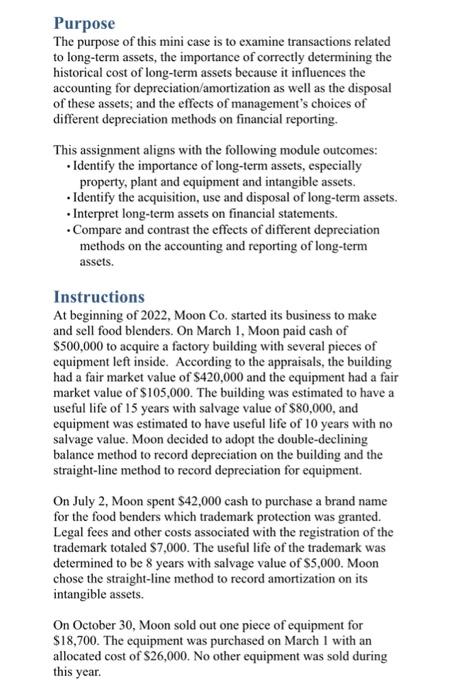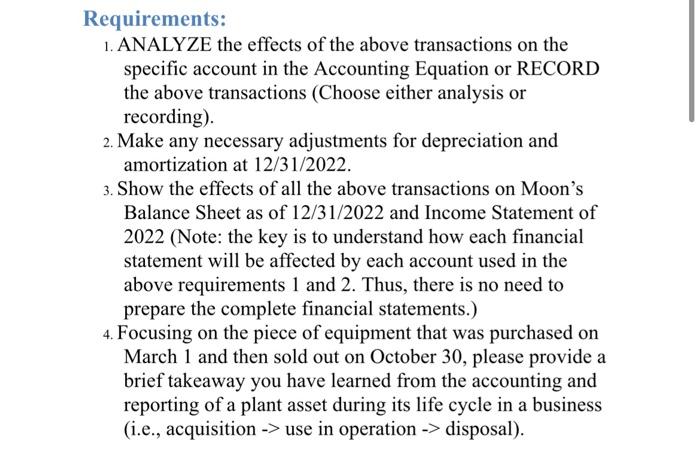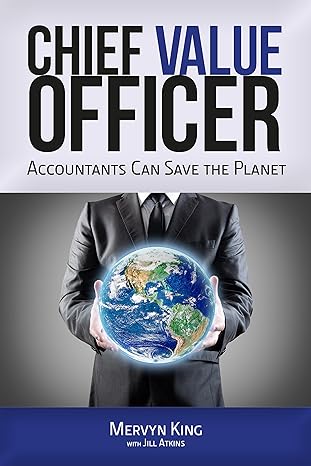This assignment aligns with the following module outcomes: - Identify the importance of long-term assets, especially property, plant and equipment and intangible assets. - Identify the acquisition, use and disposal of long-term assets. - Interpret long-term assets on financial statements. - Compare and contrast the effects of different depreciation methods on the accounting and reporting of long-term assets. Instructions At beginning of 2022, Moon Co. started its business to make and sell food blenders. On March 1, Moon paid cash of $500,000 to acquire a factory building with several pieces of equipment left inside. According to the appraisals, the building had a fair market value of $420,000 and the equipment had a fair market value of $105,000. The building was estimated to have a useful life of 15 years with salvage value of $80,000, and equipment was estimated to have useful life of 10 years with no salvage value. Moon decided to adopt the double-declining balance method to record depreciation on the building and the straight-line method to record depreciation for equipment. On July 2, Moon spent $42,000 cash to purchase a brand name for the food benders which trademark protection was granted. Legal fees and other costs associated with the registration of the trademark totaled $7,000. The useful life of the trademark was determined to be 8 years with salvage value of $5,000. Moon chose the straight-line method to record amortization on its intangible assets. On October 30, Moon sold out one piece of equipment for $18,700. The equipment was purchased on March 1 with an allocated cost of $26,000. No other equipment was sold during this year. 1. ANALYZE the effects of the above transactions on the specific account in the Accounting Equation or RECORD the above transactions (Choose either analysis or recording). 2. Make any necessary adjustments for depreciation and amortization at 12/31/2022. 3. Show the effects of all the above transactions on Moon's Balance Sheet as of 12/31/2022 and Income Statement of 2022 (Note: the key is to understand how each financial statement will be affected by each account used in the above requirements 1 and 2 . Thus, there is no need to prepare the complete financial statements.) 4. Focusing on the piece of equipment that was purchased on March 1 and then sold out on October 30, please provide a brief takeaway you have learned from the accounting and reporting of a plant asset during its life cycle in a business (i.e., acquisition > use in operation > disposal). This assignment aligns with the following module outcomes: - Identify the importance of long-term assets, especially property, plant and equipment and intangible assets. - Identify the acquisition, use and disposal of long-term assets. - Interpret long-term assets on financial statements. - Compare and contrast the effects of different depreciation methods on the accounting and reporting of long-term assets. Instructions At beginning of 2022, Moon Co. started its business to make and sell food blenders. On March 1, Moon paid cash of $500,000 to acquire a factory building with several pieces of equipment left inside. According to the appraisals, the building had a fair market value of $420,000 and the equipment had a fair market value of $105,000. The building was estimated to have a useful life of 15 years with salvage value of $80,000, and equipment was estimated to have useful life of 10 years with no salvage value. Moon decided to adopt the double-declining balance method to record depreciation on the building and the straight-line method to record depreciation for equipment. On July 2, Moon spent $42,000 cash to purchase a brand name for the food benders which trademark protection was granted. Legal fees and other costs associated with the registration of the trademark totaled $7,000. The useful life of the trademark was determined to be 8 years with salvage value of $5,000. Moon chose the straight-line method to record amortization on its intangible assets. On October 30, Moon sold out one piece of equipment for $18,700. The equipment was purchased on March 1 with an allocated cost of $26,000. No other equipment was sold during this year. 1. ANALYZE the effects of the above transactions on the specific account in the Accounting Equation or RECORD the above transactions (Choose either analysis or recording). 2. Make any necessary adjustments for depreciation and amortization at 12/31/2022. 3. Show the effects of all the above transactions on Moon's Balance Sheet as of 12/31/2022 and Income Statement of 2022 (Note: the key is to understand how each financial statement will be affected by each account used in the above requirements 1 and 2 . Thus, there is no need to prepare the complete financial statements.) 4. Focusing on the piece of equipment that was purchased on March 1 and then sold out on October 30, please provide a brief takeaway you have learned from the accounting and reporting of a plant asset during its life cycle in a business (i.e., acquisition > use in operation > disposal)








